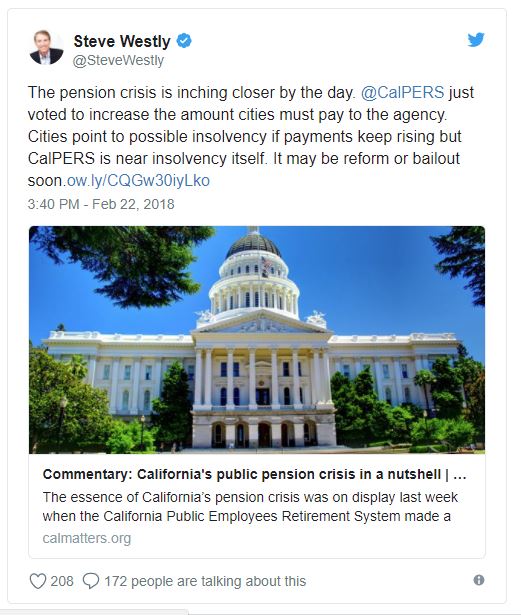Two weeks ago, in the aftermath of the February 5 volocaust, we quoted David Hunt, CEO of $1.2 trillion asset manager PGIM, who said ignore the volatility spike, the real financial timebomb was and remains public pensions: "if you were going to look for what’s the possible real crack in the financial architecture for the next crisis, rather than looking in the rearview mirror, pension funds would be on our list."
In a brief discussion wondering what municipalities and states will do when local tax revenues decline and unemployment worsens, Hunt said "we're worried about those pension obligations.”
He is hardly alone: having reported over and over and over (and over, and over) again that public pensions are in deep trouble, two days ago none other than Steve Westly, former California controller and Calpers board member - manager of the largest public pension fund in the US, made a stunning admission, confirming everything:
"The pension crisis is inching closer by the day. CalPERS just voted to increase the amount cities must pay to the agency. Cities point to possible insolvency if payments keep rising but CalPERS is near insolvency itself. It may be reform or bailout soon."

Westly was referring to an editorial laying out "the essence" of California’s pension crisis, exposed last week when the $350 billion California Public Employees Retirement System (CalPERS) made a "relatively small change" in its amortization policy.
Specifically, the CalPERS board voted to change the period for recouping future investment losses from 30 years to 20 years. While this may not sound like much, the bottom line is that it would require the California state government and thousands of local government agencies and school districts "to ramp up their mandatory contributions to the huge trust fund."
As author Dan Walters observes, with client agencies – cities, particularly – already complaining that double-digit annual increases in CalPERS payments are driving some of them towards insolvency, the new policy - which kicks in next year - will raise those payments even more.
“What we are trying to avoid is a situation where we have a city that is already on the brink, and applying a 20-year amortization schedule would put them over the edge,” a representative of the League of California Cities, Dane Hutchings, told the CalPERS board before its vote.
CalPERS, however, has no choice because as both Walters and Westly claim, America's largest public pension fund itself is on the brink, "and the policy change is one of several steps it has taken to avoid a complete meltdown."
As we have reported previously, the Calpers system, once more than 100 percent funded, now has scarcely two-thirds of what it would need to fully cover all of the pension promises to current and future retirees. And that assumes it will hit an investment earnings target of 7%per year, that many authorities criticize as being too optimistic.
Last In December we also reported that the increasingly panicked fund, decided to boost its stock allocation to 50% in order to raise its future liability discount rate to 7%, as any reduction in stock allocations would also lead to a lower discount rate which in turn which would require more contributions from cities, towns, school districts, etc. and could bring the whole ponzi crashing down. Amusingly, one Calpers board member argued to raise the equity allocation even higher, to 60%, so that the discount rate was greater than the current 7% in order to make the books appears "better."
Ironically, it was just a decade ago that Calpers' lofty equity allocation resulted in a staggering losses, and the current dead end. The trust fund lost about $100 billion in the Great Recession and never has fully recovered. In December 2016, Calpers voted to lower its earnings projection to 7.0% – it had been 7.5% – hoping to avoid another disaster were the economy to turn sour; since then it has been taking quiet steps to lever up its equity exposure once again.
Meanwhile, officials fear that were it to experience another big investment loss, it would pass a point of no return and never be able to pay for pension promises.
On the other hand, "protecting" CalPERS means getting more money from its client agencies, which could drive some of them into insolvency, as Hutchings said. This is not a hollow threat: three California cities have already gone bankrupt in recent years, in part because of their ever-increasing pension burdens, and payments have escalated sharply since then.
So on one hand, CalPERS is doing what it has to do to remain financially solvent, but on the other hand its self-protective steps threaten local government solvency.
That’s the crisis in a nutshell.
As Walters suggests, one way out would be to modify benefits in some way.
City officials, for instance, have suggested reducing automatic cost-of-living escalators in pensions over a certain mark, such as $100,000 a year.
However, the CalPERS board, dominated by public employee organizations and sympathetic politicians, has spurned such pleas: it is almost as if, once promised generous retirement benefits, public workers would rather take the entire system down, than see their own pensions reduced, even modestly.
“Our members have expressed frustration that you keep coming to them asking for more while at the same time not providing a lot of other options and assistance for them,” Dillon Gibbons of the California Special Districts Association told the board.
Alas, the options boiled down to either taxpayers get the shaft, or public employees see their pensions reduced.
In the end, it will likely be the worst of both worlds, as taxpayers are dragged in to bailout CalPERS and other retirement funds, while retirees see huge cuts to their benefits.
And the next market crash will likely catalyze it.
Meanwhile, everyone involved is waiting for the California state Supreme Court to rule on pending pension rights cases, and were it to overturn the so-called “California rule” that bars changes in benefits, it would open the door to pension modification.
CalPERS officials are also concerned that should it become insolvent, or pension payments force some cities into bankruptcy court, it would revive long-dormant plans for a statewide pension reform ballot measure.
* * *
As Walters concludes, "This crisis will haunt California for many years to come and will be a big headache for the next governor."
Unfortunately, that is an optimistic outlook, because when the crisis really hits, it will be all American taxpayers who are on the hook to bail out the country's insolvent pension funds. It is also then that some of the deepest fissures in US society: between public and private workers, between taxpayers and benefits recipients, between the young and old, all bubble to the surface at the same time, with very violent consequences.




This is quite misleading.
I've done consulting work examining the Comprehensive Annual Financial Reports for about 3 dozen cities, counties and states, to test the feasibility of public banks. This includes pension (Fiduciary) fund info. From that one can see that the good funds garner about 6%/year, though CalPERSs has not achieved this over a 10-year period, unfortunately. But here's the catches:
1. Employee/Employers already contribute about half of their own pension returns a year - that is, about 3%/year. So, the need to earn 6 (or 7)% a year is not really true, if one was to redirect tht money directly to retiree pensions, also saving 100s of millions in fees to managers who apparently cannot beat the S&P 500, and who fall WAY short on a risk-adjusted basis, and who seem poised to over-buy stocks just at the peak of a record long bull market...again.
2. State Governments could return to doing what they used to do before Wall Street convinced them that the path to pension riches lay in using the market to pay pensions. Using market returns is a particularly poor way to pay pensioners, when governments can simply tax to pay that...and by refinancing bond obligations with part of the rest of CalPERS, improve their credit rating so they can borrow more cheaply in the future and save the millions they would have to tax for, making this a win-win wash. Remember, 94-95% of pension funds are NEVER paid out, but simply are retained to - supposedly - generate an ROI to pay pensions. This is not very efficient even for individuals, but it is just wrong-headed policy for governments with taxing authority.
Interesting, thanks for sharing.